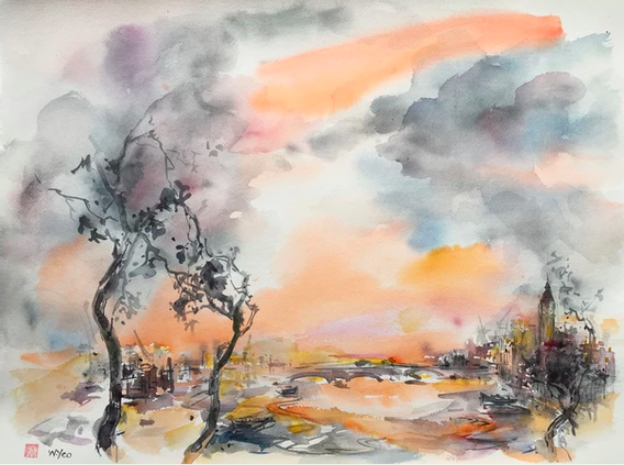“Art lives on…”
Paul Zimmerman in conversation with Wendy Yeo
Paul Zimmerman: Your were born in Hong Kong and have been living in England for many years.
How does your multicultural experience influence your art?
Wendy Yeo: I was born in Hong Kong and was educated there before I left for England at the age of 18. Before leaving Hong Kong, I was taught Chinese traditional painting and on going to England I studied at the Slade School of Fine Art, University College, London. My experience of the Chinese and Western cultures influenced me a lot so that my aim in my paintings is to combine Eastern and Western art values.
PZ: How do you find the balance between traditional and contemporary ?
WY: I think, as an artist today, on the one hand one has to be aware of Contemporary Art with one’s own vision and individuality, but on the other hand it is important not to throw away traditional values such as “drawing”, “perspective”, “tones” and “colour”.
PZ: How do you identify yourself as an artist?
WY: I can identify myself as an artist because I see things by absorbing and analyzing three-dimensional shapes, and observing color, tone and perspective in one’s surroundings such as in interiors, landscapes, townscapes, with my own individual interpretation.
PZ: Your watercolors have a meditative quality. Is there a spiritual aspect to you work?
WY: It is true that in my watercolor paintings there is a connection to Chinese/Eastern art as the traditional Chinese painters never painted on canvas nor used oils or acrylic paint. I am often involved in creating Zen(or Chan) paintings using a lot of black ink and tones with fast brushwork. This type of painting is related to Buddhism and perhaps it would be somewhat spiritual: often I feel that one of my Zen paintings I did in a “flash” as if I had not done it myself!
PZ: Have your practice changed over time?
WY: Yes, my practice in my work has changed over time as I feel that life changes and one should not stand still!
PZ: How do you know when the painting is finished?
WY: When I know that a painting is finished is, if after two or three days I look at it again and feel that it doesn’t require further work, I then know that it is a finished painting.

Westminster Bridge at Sunset, watercolor, 29″ x 22″
PZ: How do you see the role of art in our society?
WY: The role of art in our society is important as it stimulates creativity in every type of work and it also gives visual pleasure in a similar way that listening to music gives pleasure. Also, art that humanity has created from the earliest times – tens of thousands of years ago – and down through the ages, “lives on”, e.g. the prehistoric cave paintings.
PZ: Which artists are you most influenced by?
WY: I’m not influenced by any particular artist. However I greatly admire three important artists, namely Van Gogh for the vitality in his paintings; Rembrandt for his wonderful portraits in which he manages to capture the soul of the subject apart from their superficial appearance, and finally Paul Klee for being the most imaginative.
PZ: What are you working on now?
WY: I am involved in the movement and cycles of nature, e.g. movement in waterfalls and in ocean tides. Also in other natural movement as in the cycles of the seasons, day and night, sunrise/sunset.
PZ: How does the pandemic influence your work and sensibility?
WY: The Pandemic has made me more in tune with nature and I feel that I wish to escape from the depressing regular news bulletins of many thousands of people falling seriously ill and dying with the virus and, because of the “lock-down”, it gives artists time to paint solitarily with little interruption and time to create.
